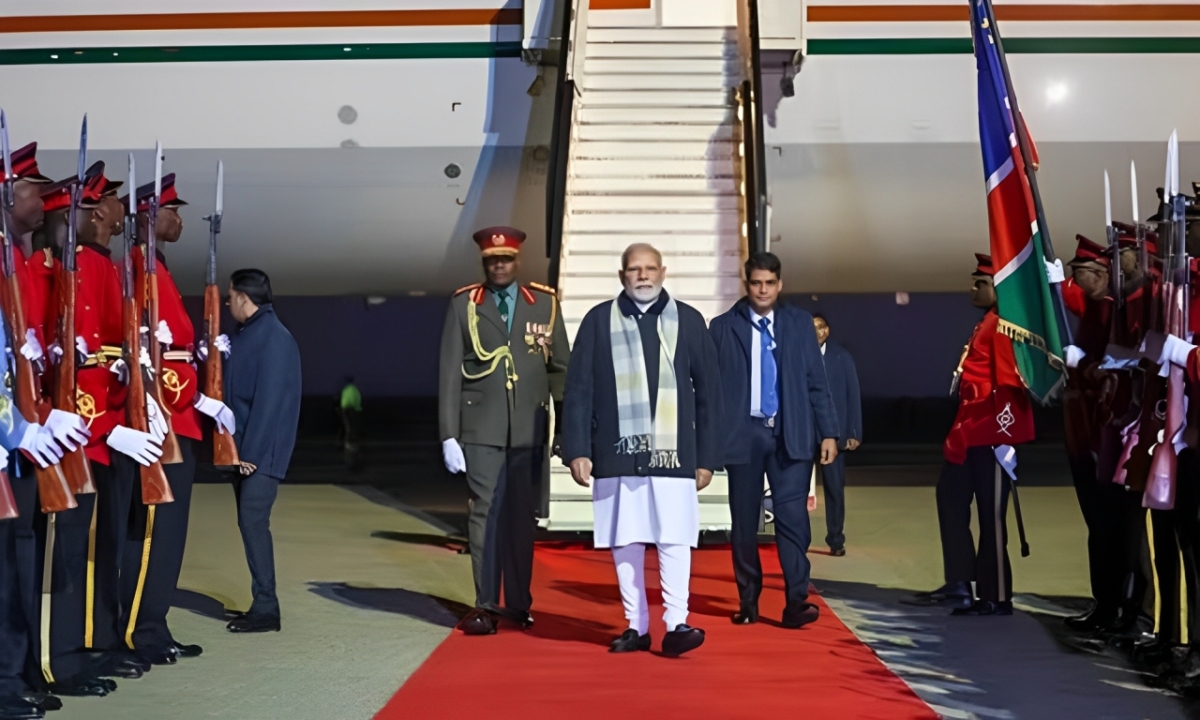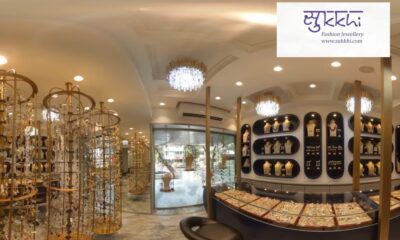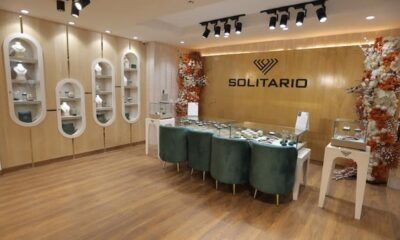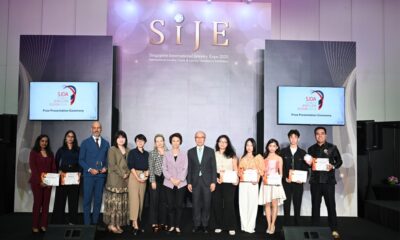DiamondBuzz
Firefly Diamonds Raises $3 Million to Expand Retail and R&D for Lab-Grown Diamond Jewellery
The funding will help Firefly Diamonds increase its retail footprint across India and accelerate the development of new jewellery collections, as the lab-grown diamond market gains momentum.

Firefly Diamonds, a startup specializing in lab-grown diamond jewellery, has secured $3 million in a seed funding round led by WestBridge Capital. The company plans to use the fresh capital to expand its retail presence and accelerate research and development for new jewellery collections. Currently, Firefly operates stores in four cities—Mumbai, Pune, Bengaluru, and Hyderabad—and aims to grow its presence to over 20 locations within the next two years.
This investment comes amid growing competition in India’s $2.6 billion lab-grown diamond (LGD) market, which has seen a surge in startup activity. Many of Firefly’s competitors, such as Aukera Jewellery, Limelight Lab Grown Diamonds, and GIVA, have either raised funds or are in the process of securing investments.

Adit Bhansali, co-founder of Firefly Diamonds, said, “Our brand is built on a legacy of trust, innovation, and craftsmanship. With over 60 years of expertise in jewellery manufacturing and design, we ensure that every piece reflects unparalleled quality and excellence. With this funding, we wish to usher in a new era of Indian luxury, celebrating beauty, individuality, and fine craftsmanship.”
Founded in December 2023, Firefly offers a range of lab-grown diamond jewellery set in 14K and 18K gold. The brand also provides several customer initiatives, such as the Firefly Try at Home service, the Firefly Sparkle Plan (an instalment-based savings plan), an Old Gold Exchange program, and Firefly Reserve, a bespoke line of high-end jewellery.
The lab-grown diamond market in India is rapidly growing, with an estimated value of $2.61 billion in 2023. It is expected to reach $8.31 billion by 2032, driven by a compound annual growth rate (CAGR) of 13.73%. While traditional jewellers continue to dominate the market, no clear leader has emerged in the LGD segment, providing room for startups like Firefly to grow in the space.
As of now, India is home to 2,836 internet-first jewellery startups, with 262 receiving funding. However, only 79 of these startups have raised Series A funding, underscoring the competitive nature of the market.

DiamondBuzz
PM Modi arrives in Namibia; India seeks direct access to diamond reserves
Prime Minister Narendra Modi is visiting Namibia as part of his five-country outreach tour. Namibia, rich in minerals such as uranium and diamonds, holds strategic importance for India

Prime Minister Narendra Modi is visiting Namibia as part of his five-country outreach tour. Namibia, rich in minerals such as uranium and diamonds, holds strategic importance for India.
Modi is visiting Namibia at the invitation of President Nandi-Ndaitwah, the Ministry of External Affairs (MEA) said in a press release in New Delhi ahead of Modi’s five-nation tour to Ghana, Trinidad & Tobago, Argentina, Brazil and Namibia.During his visit, the prime minister will hold bilateral talks with President Nandi-Ndaitwah.
Namibia has the world’s richest known marine diamond deposits, estimated at over 80 million carats. Currently, Namibia’s rough diamonds reach India indirectly through hubs like London and Antwerp. During this visit, PM Modi is expected to explore ways to establish more direct diamond trade links between the two countries.
India has invested more than $ 800 million (about ₹ 6,600 crores) in Namibia in many sectors including mining, manufacturing, diamond processing and services.Apart from diamonds, cobalt, lithium and rare earth elements and minerals are found in Namibia, which are important for India to move towards clean energy.
Bilateral trade has shown strong growth. In 2022-23, trade stood at $278 million, with India’s exports at $240 million. From April to November 2023, two-way trade surged by 178%, reaching $654 million. India’s exports totaled $418 million, while imports from Namibia were $235 million.
DiamondBuzz
Fancy Colour Diamond prices soar 205% since 2005 amid growing luxury demand, Says NDC
Prices for fancy colour diamonds have surged by an impressive 205% since 2005, according to a new report by the Natural Diamond Council (NDC), in collaboration with Choron Group and the Fancy Color Research Foundation (FCRF).

These exceptionally rare gems—known for their vivid hues of pink, blue, yellow, green, and red—now rank among the most sought-after and resilient assets in the natural diamond market.
Representing just 0.01% of all natural diamonds mined, fancy colour diamonds have captured growing interest from collectors, luxury jewellery houses, and investors. Data from the FCRF shows that pink diamonds have skyrocketed in value by nearly 394% over the past two decades, while blue diamonds have risen by over 240%, and yellow diamonds by almost 50%. Overall, fancy colour diamonds have posted a compound annual growth rate (CAGR) of 5.7%.
Once considered a niche category, these vibrant stones now feature prominently in high-profile auctions and luxury jewellery collections. Recent standout sales include the 10.03-carat Mediterranean Blue diamond, which fetched $21.4 million at Sotheby’s Geneva—more than $2.1 million per carat—and the historic 10.38-carat Marie-Thérèse Pink, sold at Christie’s New York for nearly $14 million.
Auction houses are increasingly showcasing a broader selection of fancy colour diamonds, driven by both aesthetic allure and their perceived long-term investment value, especially in today’s uncertain economic climate.
Supply remains extremely limited, with fancy colour diamonds mined in only a few regions globally—such as Canada, Botswana, South Africa, Sierra Leone, and the now-closed Argyle mine in Australia—adding to their exclusivity.
As luxury consumers place greater emphasis on rarity, provenance, and artistry, fancy colour diamonds are expected to maintain their prominence. With upcoming events like Paris Haute Couture Week, these extraordinary gems are poised to continue leading trends in high jewellery, elite auctions, and alternative investments.
DiamondBuzz
ALROSA’s Severalmaz ramps up output as Karpinsky-2 diamond pipe enters development
Russian diamond giant ALROSA has begun full-scale development of the Karpinsky-2 kimberlite pipe at the M.V. Lomonosov diamond field in the Arkhangelsk region, marking a major step forward for its local subsidiary, Severalmaz. Karpinsky-2 becomes the third active pipe at the site, alongside the existing Arkhangelsk and Karpinsky-1 operations.

Karpinsky-2 holds more than 40 million tonnes of diamond-bearing ore and was first evaluated in 2018 through pilot mining operations, which confirmed its commercial viability. Preparatory work for full development began earlier this year, and the project officially moved into the design phase during a recent visit by ALROSA CEO Pavel Marinychev.
Marinychev, who personally launched the design stage, also assessed Severalmaz’s performance for 2025 during his visit. In the first five months of the year, the company surpassed its ore extraction targets and improved operational efficiency, resulting in a 9.4% increase in ore processing. These gains translated into the production of more than 1.2 million carats of rough diamonds.
The CEO also reviewed progress on a new water recycling system at the Lomonosov processing plant and emphasized the importance of completing a gym facility for workers at the shift village by year-end, highlighting the company’s focus on both sustainability and employee well-being.
“I am sure that the work of the Severalmaz team will drive the enterprise’s continued growth. We remain committed to providing safe working conditions and contributing to the development of the Arkhangelsk region,” Marinychev stated.
ALROSA, which produces about 30% of the world’s diamonds and 90% of Russia’s output, reported production of 33 million carats in 2024. The company’s proven reserves exceed 1 billion carats, solidifying its position as the global leader in diamond mining.
-

 National News6 days ago
National News6 days agoMalabar Gold & Diamonds Inaugurates Landmark Integrated Manufacturing Site in Hyderabad, Cementing Its Position as a Global Manufacturing Leader
-

 National News2 months ago
National News2 months agoEmmadi Silver Jewellery Launches First Karnataka Store with Grand Opening in Bengaluru’s Malleshwaram
-

 BrandBuzz3 months ago
BrandBuzz3 months agoMia by Tanishq Unveils ‘Fiora’ Collection This Akshaya Tritiya: A Celebration of Nature’s Blossoms and New Beginnings
-

 GlamBuzz2 months ago
GlamBuzz2 months agoGokulam Signature Jewels Debuts in Hyderabad with Glamorous Launch at KPHB











